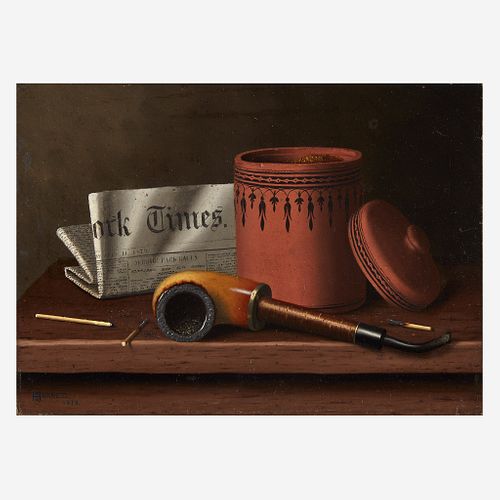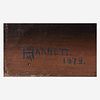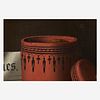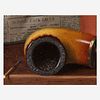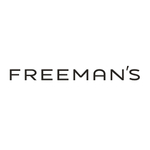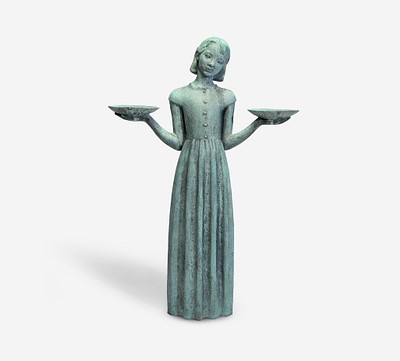William Michael Harnett (American, 1848–1892) Still Life with New York Times, Tobacco Jar, Pipe and Matches
About Seller
2400 Market St
Philadelphia, PA 19147
United States
Established in 1805, Freeman’s Auction House holds tradition close, with a progressive mind-set towards marketing and promotion, along with access to a team of top experts in the auction business. And now with offices in New England, the Southeast, and on the West Coast, it has never been easier to ...Read more
Two ways to bid:
- Leave a max absentee bid and the platform will bid on your behalf up to your maximum bid during the live auction.
- Bid live during the auction and your bids will be submitted real-time to the auctioneer.
Bid Increments
| Price | Bid Increment |
|---|---|
| $0 | $25 |
| $500 | $50 |
| $1,000 | $100 |
| $2,000 | $200 |
| $3,000 | $250 |
| $5,000 | $500 |
| $10,000 | $1,000 |
| $20,000 | $2,000 |
| $30,000 | $2,500 |
| $50,000 | $5,000 |
| $100,000 | $10,000 |
About Auction
Jun 6, 2021
Freeman’s is pleased to present Sylvia Shaw Judson’s Bird Girl, the highlight of the June 6 auction. In addition to the sculpture, this auction will also feature several notable works by significant American artists, including Daniel Garber, Norman Rockwell, Edward Redfield, and William Harnett. Freeman's info@freemansauction.com
- Lot Description
William Michael Harnett (American, 1848–1892) Still Life with New York Times, Tobacco Jar, Pipe and Matches
Signed with Artist's initialed monogram and dated 'Wm HARNETT./1879.' bottom left, oil on canvas
10 x 14 in. (25.4 x 35.6cm)
Unframed.Provenance
Private Collection, Chicago, Illinois.
Footnote:Note
William Harnett is mostly known for his trompe l'oeil still-lifes, often featuring trophy hunts, pistols, tankards, music sheets, instruments and all sorts of ordinary, everyday items. An undisputed champion of illusionism, he perfected his meticulous style at the Pennsylvania Academy of the Fine Arts, where he studied 17th Century Old Masters, in addition to discovering the art of Raphaelle Peale.
In January 1880, Harnett sailed to Europe and stayed in Munich between 1881 and 1886, as revealed by the artist's signature of Lot 8. While on the Old Continent, his painting took a new, drastic turn. The artist famously went on to produce a series of extremely small canvases marked by a freer technique, and a deft, miniaturistic, almost microscopic touch. His new style culminated in a series of eleven recorded horizontal still-lifes, all involving a tabletop with a gray stoneware jug or beer stein at the right, a Meerschaum pipe laid flat, a book and a folded, dated, newspaper.
Larger in size and looser in technique (judging from the beautifully textured edges of the pipe at center), the present lot evidently predates Harnett's series of small canvases. It was most likely executed in the United States, just before the artist embarked on his European journey, and therefore provides an insightful perspective into the artist's technical evolution. The still-life channels hallmarks of Harnett's known, earlier oeuvre, and yet also touches on a new burgeonning style. In the foreground stands a wooden table-top, with edges parallel to the picture plane - a trait typical of Harnett and unlike the non-illusionistic painters, who preferred to introduce tables at an angle so as to lead the viewer's eye into deep space. On it, one can spot a yellow pipe, tobacco jar and burnt matches - all recurring props in Harnett's compositions. However, the artist introduces a new, bold and dramatic element to his sill life at upper left: a folded copy of the New York Times. Dated July 11, 1879, the cover features the Jerome Park Racetrack, an American thoroughbred horse racing facility in Westchester County, New York.
The presence of a dated newspaper is meant to reinforce the illusion of reality, and ground the picture in a known, relatable and realistic dimension. Here however, the folded newspaper paradoxically conveys a sense of timelesness, especially in regards to the abstract, neutral dark green/black backdrop. This atmosphere is typical of Harnett's pre-1880 canvases. It gives the picture space a definite, shallow limit, enabling the viewer's eye to focus on the table-top in the foreground, and not be distracted by a "noisy" background. In short, it enhances the effect of trompe l'oeil. In his later canvases, Harnett will abandon this neutrality to render a meticulously-rendered background, alternatively draped by a piece of cloth, or fully carved and decorated. It is as if the artist drifted away from timelesness, and instead wished to capture time through a specific decor forever immortalized on the picture place.
When comparing the present work to later examples, one also notices a newfound attention to space and volume, which will continue to preoccupy Harnett later on. Here, for one of the first times in his career, the artist introduces a deep, dark recess on the right-hand side of the still-life, which helps the tobocco jar to dramatically stand out in the composition (it is the only true vertical of the painting). Harnett also chose to fully reveal the left-hand corner of the table-top, which was rarely, if not ever the case before. Not only does it help deepen the picture plane, and push it further out, but it also helps catch the intense lighting coming from the left.
Condition report:The (apparently) unlined work is unframed, and presents well. With a lightly glossy varnish, some abrasions along the outer edges of the canvas, a pinpoint hole at bottom left corner (underneath the signature), and remnants of old gold leaf alongside the bottom outer edge. We notice the mark of the upper stretcher bar running along the top edge of the work (mostly through the background). Examination under UV light reveals minor remnants of varnish on the tobacco jar (across its top edge) and its lid at center and center right. With minor areas of restoration at bottom center (on the table, underneath the pipe), in the background at upper right and upper left (visible with the naked eye). Main dots of restoration can be seen on the jar: in the middle at center right, and alon its top rim as well. See specialist's pictures for more details.
- Shipping Info
-
No lot may be removed from Freeman’s premises until the buyer has paid in full the purchase price therefor including Buyer’s Premium or has satisfied such terms that Freeman’s, in its sole discretion, shall require. Subject to the foregoing, all Property shall be paid for and removed by the buyer at his/ her expense within ten (10) days of sale and, if not so removed, may be sold by Freeman’s, or sent by Freeman’s to a third-party storage facility, at the sole risk and charge of the buyer(s), and Freeman’s may prohibit the buyer from participating, directly or indirectly, as a bidder or buyer in any future sale or sales. In addition to other remedies available to Freeman’s by law, Freeman’s reserves the right to impose a late charge of 1.5% per month of the total purchase price on any balance remaining ten (10) days after the day of sale. If Property is not removed by the buyer within ten (10) days, a handling charge of 2% of the total purchase price per month from the tenth day after the sale until removal by the buyer shall be payable to Freeman’s by the buyer. Freeman’s will not be responsible for any loss, damage, theft, or otherwise responsible for any goods left in Freeman’s possession after ten (10) days. If the foregoing conditions or any applicable provisions of law are not complied with, in addition to other remedies available to Freeman’s and the Consignor (including without limitation the right to hold the buyer(s) liable for the bid price) Freeman’s, at its option, may either cancel the sale, retaining as liquidated damages all payments made by the buyer(s), or resell the property. In such event, the buyer(s) shall remain liable for any deficiency in the original purchase price and will also be responsible for all costs, including warehousing, the expense of the ultimate sale, and Freeman’s commission at its regular rates together with all related and incidental charges, including legal fees. Payment is a precondition to removal. Payment shall be by cash, certified check or similar bank draft, or any other method approved by Freeman’s. Checks will not be deemed to constitute payment until cleared. Any exceptions must be made upon Freeman’s written approval of credit prior to sale. In addition, a defaulting buyer will be deemed to have granted and assigned to Freeman’s, a continuing security interest of first priority in any property or money of, or owing to such buyer in Freeman’ possession, and Freeman’s may retain and apply such property or money as collateral security for the obligations due to Freeman’s. Freeman’s shall have all of the rights accorded a secured party under the Pennsylvania Uniform Commercial Code.
-
- Buyer's Premium



 EUR
EUR CAD
CAD AUD
AUD GBP
GBP MXN
MXN HKD
HKD CNY
CNY MYR
MYR SEK
SEK SGD
SGD CHF
CHF THB
THB